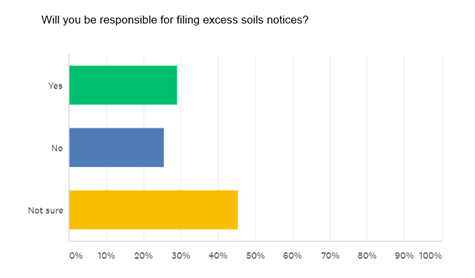Excess soil registry update – RPRA working with industry and on track to complete build
RPRA is on track to complete the build of the excess soil registry, which will enable the industry to meet its notice filing requirements under the On-Site and Excess Soil Management Regulation.
The first two stages of the registry project focus on designing the registry to meet the regulatory requirements, the business needs of registry users and the requirements of the Minister’s direction. To do this, RPRA has been working in close coordination with industry, the Ministry and PwC Canada (RPRA’s technical vendor for the project). Here is a summary of the progress made over the Summer:
Industry Stakeholder Working Group
Based on the Ministry’s recommendation, a cross-section of industry representatives was invited to participate in the Industry Stakeholder Working group, who are being consulted throughout the process of building the registry. To date, we have held five working group meetings to gain insight into registry users’ concerns and needs and industry practices to inform the design and build of the registry. We have also held one-on-one interviews and correspondence with stakeholders. We will continue to engage the working group to gain their insight on the design and delivery of training resources and methods that will be used to support the wider industry to use the registry.
Communications Survey
To ensure that RPRA is effectively communicating around the excess soil registry and that registry users have the information they need to use the registry, we invited the working group and the wider industry to take part in a communications survey. The results of the survey are being used to inform RPRA’s outreach plan in the lead-up to the launch of the registry. A key finding was that almost half of respondents said they were not sure if they would be responsible for filing excess soil notices. This indicates that there is a need for RPRA and the Ministry to develop materials that will provide further clarifications about who is required to file a notice and when.

Registry Design Workshops
The majority of Industry Working Group meetings have been focused on getting feedback on how best to design the registry to enable users to submit filings. During the most recent meetings, industry representatives have been shown wireframes (a visual layout or blueprint of the web design) and walked through the initially suggested filing processes for each of the three required types of notice filings:
- Residential development soil depot notice filings, which will be required before excess soil is deposited on a residential development soil depot site (subject to certain exceptions). There will be two stages for each notice filing – an initial notice filing before soil is received at a residential development soil depot and a final notice filing when the depot is closed. Notice filings will include key information regarding the site location, applicable site instruments, and information about the soil stored at the residential development soil depot.
- Reuse site notice filings, which will be required when at least 10,000 m3 of excess soil is expected to be deposited for an undertaking at a reuse site (subject to certain exceptions). There will be two stages for each notice filing – an initial notice filing ahead of the soil being deposited and a final notice filing when the soil is placed. Notice filings will include key information regarding the site location, the quality of the soil being deposited and the dates when the first and final loads are expected to be placed.
- Project area notice filings, which will be required before excess soil is removed for a development, construction, or infrastructure project in the province. Although some exemptions may apply, the requirement generally applies to projects that generate 2,000 m3 of excess soil or more. There will be two stages for each filing – an initial notice filing at the beginning of the project and a final notice filing when the final load of excess soil is removed from the project area. Notice filings will include key information about the project, the amount and quality of the soil that will be generated and details of the end sites where the soil will be placed.
RPRA and PwC are currently working to incorporate the feedback from the working group into the design and build of the registry. We will be posting information about the registry project, including project progress and updates, upcoming events and learning opportunities, and key dates and deadlines on the project webpage.
In the coming months, we will share more information about how we will set and collect fees to recover the costs for the registry development, deployment and ongoing support to regulated persons.
If you would like to be notified when we post an update or have a question related to the project, please email us at registry@rpra.ca.
The Ministry of the Environment, Conservation and Parks will continue to be responsible for policy and programs related to excess soil and will continue to conduct compliance and enforcement activities under the Excess Soil Regulation. Please direct all questions related to the regulation to the ministry via MECP.LandPolicy@ontario.ca